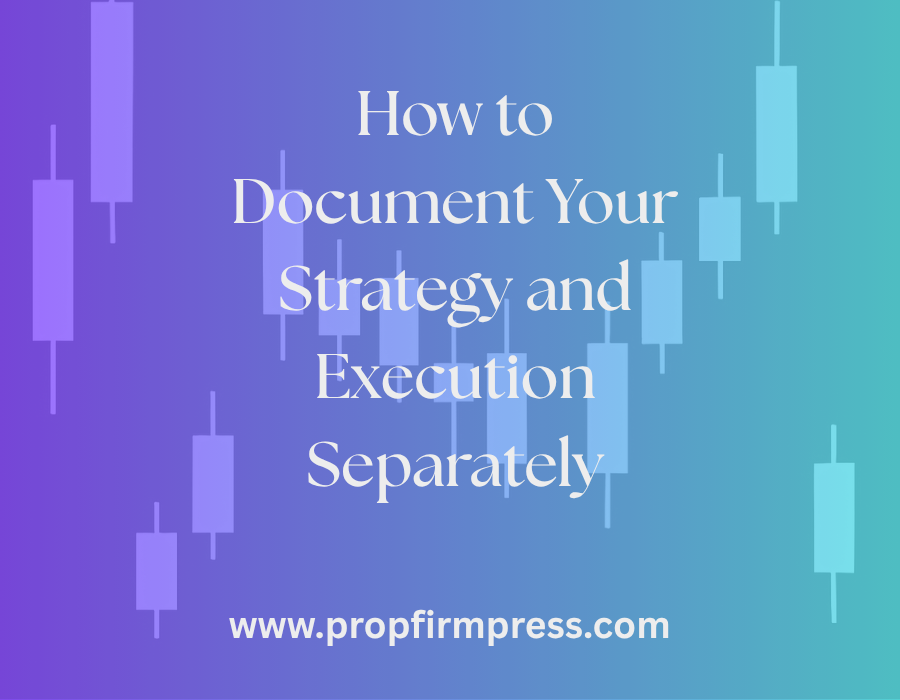Why Separating Strategy and Execution Matters
For traders pursuing prop firm funding, precision in journaling is essential. Many make the mistake of lumping everything into one block of notes, failing to distinguish between the plan (strategy) and the actual trade outcome (execution). But documenting these two elements separately is one of the fastest ways to isolate what’s working—and what’s not. Whether you’re trading with Bulenox, Prop Shop Traders, or Funded Futures Network, separating your strategy from your execution allows for a level of clarity that simply can’t be achieved otherwise.
What to Include in the ‘Strategy’ Section
Think of the strategy section as your pre-market or pre-trade blueprint. This is where you outline the logic, signals, and expectations before you enter the trade. Here’s what to include:
- Setup Description: Define the pattern, zone, or condition that triggered your trade idea.
- Timeframe: Note whether you’re using the 1-minute, 5-minute, or higher timeframe.
- Entry Criteria: Be clear about what needs to happen for you to take the trade.
- Stop Loss & Target: Predefine your risk-reward levels.
- Market Conditions: Record any relevant context, such as news events or trend direction.
By treating your strategy section as a written ‘trade plan,’ you create accountability and reinforce your process.
What to Include in the ‘Execution’ Section
Execution is what actually happened. It’s where you reflect on how well you followed your plan. This section can reveal discipline issues, hesitation, overtrading, or other behavior-based mistakes. Include:
- Actual Entry/Exit: Record the real-time entry and exit, including time and price.
- Did You Follow the Plan? Yes or no—and why.
- Execution Grade: Give yourself a score based on discipline, timing, and rule adherence.
- Emotional State: Briefly note your mindset: confident, anxious, FOMO, bored, etc.
- Distractions or Influences: Record any outside factors (e.g., news alerts, social media).
The Benefits of This Dual-Tracking Approach
When you start splitting strategy and execution, you unlock several advantages:
- Clearer Data: You can now separate strategic errors from execution mistakes.
- Behavior Patterns: Spot emotional or reactive tendencies more easily.
- Improvement Path: Know exactly where to focus—on refining setups or building discipline.
- Higher Prop Firm Pass Rates: Many failures in evaluations stem from poor execution, not bad strategies. Fixing execution is often the missing link.
Example Format Using Prop Firm Press Journal Sheets
Use a two-column layout: the left side for strategy, the right side for execution. A printable sheet or a digital spreadsheet like the Prop Firm Press Journal Sheets can simplify this.
- Left Column: Pre-market plan, expected entries, risk-reward setup.
- Right Column: Real trades taken, changes made, reasons for deviations.
This structure ensures you’re documenting both the theory and reality of each trading day.
Color-Coding for Quick Reviews
Consider assigning colors to track different components. For example:
- Green: Strategy followed and profitable
- Yellow: Strategy followed but lost
- Red: Strategy broken (impulsive trade, overleveraged, revenge trading)
This simple visual system can dramatically speed up weekly or monthly review sessions.
Common Mistakes to Avoid
Many traders blur the lines between planning and reacting. Watch out for:
- Backfilling the Strategy: Writing a plan after the trade is over—this undermines learning.
- Emotional Editing: Avoid sugarcoating bad trades or rewriting history in your journal.
- Ignoring Strategy Data: If you’re only journaling emotional reactions and not setups, you’re missing half the picture.
Build It into Your Routine
Make strategy and execution journaling part of your daily flow. For example:
- Before Market Open: Fill out strategy section.
- After Each Trade: Record execution notes.
- End of Day: Review both side-by-side to evaluate consistency.
Over time, this routine strengthens both discipline and strategic skill.
When You’ll See the Results
It usually takes 2–3 weeks of consistent journaling before patterns become clear. Expect to notice:
- Fewer impulse trades
- Higher win rates on your core setups
- Better emotional regulation under pressure
- Improved ability to pass prop firm challenges with fewer resets
Digital Tools That Can Help
If you’re more tech-inclined, consider apps like Notion, Excel, or TraderVue. Create two separate tabs or fields: one for the strategy (pre-trade) and one for execution (post-trade). This mirrors the same benefit of separation and structure.
The Ultimate Goal
Your end objective is to treat trading like a business. And no business thrives without accurate records. By separating strategy from execution, you’ll learn faster, trade better, and stay consistent—especially when it matters most during a prop firm evaluation or funded account phase.
If you’re ready to bring structure into your trading day, check out the full collection of printable and digital journaling resources available through Prop Firm Press. These tools were designed to simplify everything we’ve covered in this article, and make your journal work for you—not the other way around.
